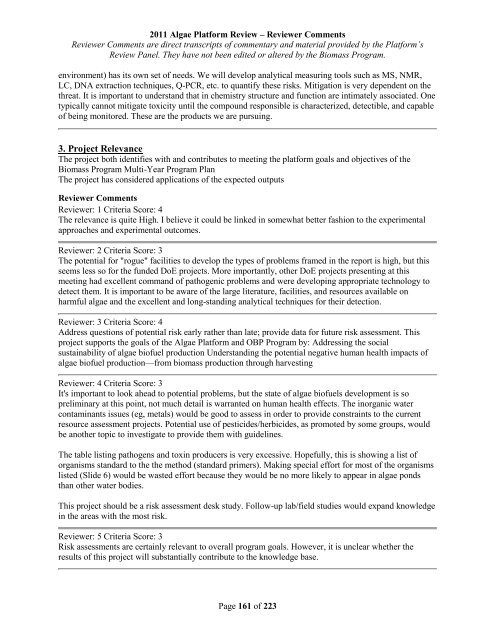Reviewer Comments - EERE
Reviewer Comments - EERE
Reviewer Comments - EERE
You also want an ePaper? Increase the reach of your titles
YUMPU automatically turns print PDFs into web optimized ePapers that Google loves.
2011 Algae Platform Review – <strong>Reviewer</strong> <strong>Comments</strong><br />
<strong>Reviewer</strong> <strong>Comments</strong> are direct transcripts of commentary and material provided by the Platform’s<br />
Review Panel. They have not been edited or altered by the Biomass Program.<br />
environment) has its own set of needs. We will develop analytical measuring tools such as MS, NMR,<br />
LC, DNA extraction techniques, Q-PCR, etc. to quantify these risks. Mitigation is very dependent on the<br />
threat. It is important to understand that in chemistry structure and function are intimately associated. One<br />
typically cannot mitigate toxicity until the compound responsible is characterized, detectible, and capable<br />
of being monitored. These are the products we are pursuing.<br />
3. Project Relevance<br />
The project both identifies with and contributes to meeting the platform goals and objectives of the<br />
Biomass Program Multi-Year Program Plan<br />
The project has considered applications of the expected outputs<br />
<strong>Reviewer</strong> <strong>Comments</strong><br />
<strong>Reviewer</strong>: 1 Criteria Score: 4<br />
The relevance is quite High. I believe it could be linked in somewhat better fashion to the experimental<br />
approaches and experimental outcomes.<br />
<strong>Reviewer</strong>: 2 Criteria Score: 3<br />
The potential for "rogue" facilities to develop the types of problems framed in the report is high, but this<br />
seems less so for the funded DoE projects. More importantly, other DoE projects presenting at this<br />
meeting had excellent command of pathogenic problems and were developing appropriate technology to<br />
detect them. It is important to be aware of the large literature, facilities, and resources available on<br />
harmful algae and the excellent and long-standing analytical techniques for their detection.<br />
<strong>Reviewer</strong>: 3 Criteria Score: 4<br />
Address questions of potential risk early rather than late; provide data for future risk assessment. This<br />
project supports the goals of the Algae Platform and OBP Program by: Addressing the social<br />
sustainability of algae biofuel production Understanding the potential negative human health impacts of<br />
algae biofuel production—from biomass production through harvesting<br />
<strong>Reviewer</strong>: 4 Criteria Score: 3<br />
It's important to look ahead to potential problems, but the state of algae biofuels development is so<br />
preliminary at this point, not much detail is warranted on human health effects. The inorganic water<br />
contaminants issues (eg, metals) would be good to assess in order to provide constraints to the current<br />
resource assessment projects. Potential use of pesticides/herbicides, as promoted by some groups, would<br />
be another topic to investigate to provide them with guidelines.<br />
The table listing pathogens and toxin producers is very excessive. Hopefully, this is showing a list of<br />
organisms standard to the the method (standard primers). Making special effort for most of the organisms<br />
listed (Slide 6) would be wasted effort because they would be no more likely to appear in algae ponds<br />
than other water bodies.<br />
This project should be a risk assessment desk study. Follow-up lab/field studies would expand knowledge<br />
in the areas with the most risk.<br />
<strong>Reviewer</strong>: 5 Criteria Score: 3<br />
Risk assessments are certainly relevant to overall program goals. However, it is unclear whether the<br />
results of this project will substantially contribute to the knowledge base.<br />
Page 161 of 223




